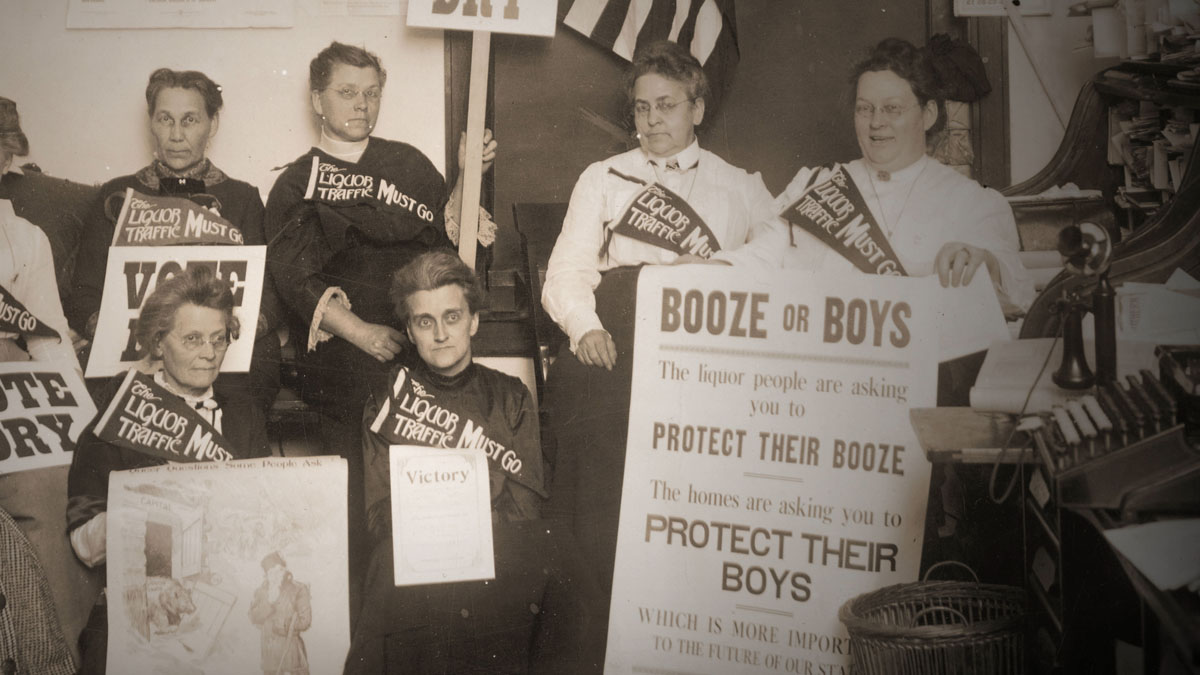
Early in part one of the two-part Smithsonian Channel special Drinks, Crime and Prohibition, a talking head looks into the camera to say people today believe they know all about the decade-long national ban on alcohol that went into full effect in 1920. But as shown in producer/director Alex Jouve’s excellent television documentary, there were many more implications to Prohibition than were depicted on HBO’s Boardwalk Empire, Brian De Palma’s The Untouchables or the 1931 William A. Wellman classic The Public Enemy starring Jimmy Cagney.
The common view is the evils of alcohol at the turn of the century prompted a counter-movement that created dry states, which snowballed into the national law that President Herbert H. Hoover called “the noble experiment.” As alcohol disappeared from the open marketplace, gangsters, bootleggers and moonshiners filled the vacuum, creating an underground economy and criminal enterprises.
Those elements of the Prohibition story are true, as is the fact the government finally gave up on the 18th Amendment to the Constitution, which forbade the sale, manufacture and distribution of alcohol for public consumption. That’s because people consume booze whether it is legal or not. By regulating it, there can at least be some control over negative societal impacts.
However, as laid out in Drinks, Crime and Prohibition, the battle between the so-called “wets and dries” actually had less to do with stemming the flow of liquor than it did with stemming the flow of European immigrants—and increasing the stream of blacks and Latinos into U.S. jails.
The temperance movement, which actually began in the U.S. in the 1820s, was still a niche group by the early 1900s, when the Ku Klux Klan was nearly dead, German transplants had created thriving breweries, and saloons had become centers of political power because that was where immigrant laborers gathered after work.
In the years leading up to 1920, the convergence of jazz, World War I, Christian values, white supremacy, female liberation and anti-immigrant sentiment re-energized not only the dries, but also the KKK and others seeking the ouster of blacks, Latinos and European immigrants, Jouve’s special argues.
Also key, Drinks, Crime and Prohibition shows, was the 1913 ratification of the 16th Amendment, which created the federal income tax. The dries actually supported this because they realized Prohibition would be a non-starter in the halls of power without a new government-funding source to replace lost taxes on alcohol.
The two-part special covers a bevy of unintended consequences of Prohibition, including bathtub gin, government wiretaps, organized crime going national, the rise of urban speakeasies and the tabloid press, and the U.S. waging chemical warfare on its own citizens. These are explained by a solid lineup of historians, weapons experts and, this being the Smithsonian Channel, museum curators, who show off some surprising inventions of the Prohibition era. You can’t stop the entrepreneurial spirit, baby!
Notables who pop up onscreen include author, journalist and my former Village Voice Media colleague Michael Musto; mixologist Derek Brown, who shows how flavors and cocktails created because of Prohibition remain in our tumblers today; and Nelson Johnson, whose best-seller Boardwalk Empire: The Birth, High Times, and Corruption of Atlantic City inspired the HBO series.
Among the great lines peeled off in Drinks, Crime and Prohibition are: “Prohibition was unenforceable from day one”; “A federal role in crime prevention barely existed before Prohibition”; and, my fave, “One thing the Roaring Twenties isn’t is sober.”
Then there is 2016 presidential candidate James “Jim” Hedges of the Prohibition Party, the country’s third-oldest political party. He has a curious take on why the 18th Amendment, which was repealed in 1933, did not fail.
As Ken Burns and Lynn Novick did in 2011 with Prohibition, their five-and-a-half-hour PBS documentary, Drinks, Crime and Prohibition got me thinking about the parallels to the government’s equally futile war on drugs. Just swap out jazz with rap, the national syndicate with the international cartels, and a prudish lack of empathy for alcoholics with a similar take on drug addicts by Jeff Sessions. No modern changes are necessary for white supremacy, anti-immigrant sentiment and the foolhardy notion that cutting supply ends demand.
Prohibition’s end game was set in motion by the St. Valentine’s Day Massacre of 1929, which capped a decade of carnage that horrified a nation, and the stock market crash that ushered in the Great Depression that impoverished a nation. Here, as in the frames before, Jouve and his team make excellent use of archival footage, historic photographs and some reenactments, although I did find repeats of the latter a bit tiresome. After a while, they just prompted me to go to the fridge for a cold one.
That beer cracking open is the sound of freedom.
Drinks, Crime and Prohibition premieres with part one on Smithsonian Channel. Mon., 8 p.m. Part two airs June 18, 8 p.m.

OC Weekly Editor-in-Chief Matt Coker has been engaging, enraging and entertaining readers of newspapers, magazines and websites for decades. He spent the first 13 years of his career in journalism at daily newspapers before “graduating” to OC Weekly in 1995 as the alternative newsweekly’s first calendar editor.

